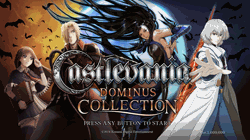 It’s October, so we should be covering Castlevania games. The most recent Castlevania release is Castlevania Dominus Collection, and, horror of horrors, Gogglebob.com has already covered every main game featured in that collection. But have no fear, gentle reader, because while we may have focused on each of these games, we all but ignored their alternative modes. And those modes are nearly as big as their main-mode brothers! We can certainly produce some content for the Content God with that!
It’s October, so we should be covering Castlevania games. The most recent Castlevania release is Castlevania Dominus Collection, and, horror of horrors, Gogglebob.com has already covered every main game featured in that collection. But have no fear, gentle reader, because while we may have focused on each of these games, we all but ignored their alternative modes. And those modes are nearly as big as their main-mode brothers! We can certainly produce some content for the Content God with that!
So, without further ado, please enjoy a brief summary of the three alternate modes contained within the Castlevania Dominus Collection. For convenience/endless debate, these modes are listed in ascending order of quality. We’ll start with the worst…
Castlevania: Portrait of Ruin
Sisters Mode
What’s the plot?
In 1944, Dracula’s castle reappears, and two vampire hunters enter the castle to banish Dracula. But before that, the last generation’s vampire hunter, Eric Lecarde, attempted to banish Dracula on his own (after his heterosexual life partner died of a chronic whip addiction). He went missing, and his daughters entered the Hell House in search of their errant father. So, to be clear, this is expedition two out of three, and that ain’t bad.
How does it go?
Sisters Mode can only be unlocked by clearing the whole of Castlevania: Portrait of Ruin once (complete with the “good ending”). Given the plot of that main story sees Eric as an undead ghost (is that redundant?) and the titular sisters as fallen vampires, you can probably guess what is waiting for Stella and Loretta at the end of this journey. But at least you can have a moderate amount of fun getting to their sorry end!
What’s different?
The sisters apparently had vast magical powers before they became vampires. Both gals can fly, Stella can psychically summon a blade to slash anywhere, and Loretta has ice magic that pumps out at about the same rate as a machine gun. The forces of Dracula never had a chance!
Does it work?
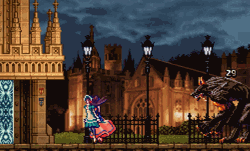 The only downside is… Well… The forces of Dracula never had a chance. This is the most you ever get to “play as a boss” in a classic IGAvania title, and it makes a great case for why you never actually do that. You can fly anywhere, so movement or “castle mazes” are not an issue in the slightest. 90% of standard enemies can be torn to shreds the minute they appear on screen, and bosses are little more than an excuse to find a “safe spot” and then murder away for a minute. The sisters have zero healing options beyond save points, but the odds of a single monster coming anywhere near you are low enough that it is not a concern.
The only downside is… Well… The forces of Dracula never had a chance. This is the most you ever get to “play as a boss” in a classic IGAvania title, and it makes a great case for why you never actually do that. You can fly anywhere, so movement or “castle mazes” are not an issue in the slightest. 90% of standard enemies can be torn to shreds the minute they appear on screen, and bosses are little more than an excuse to find a “safe spot” and then murder away for a minute. The sisters have zero healing options beyond save points, but the odds of a single monster coming anywhere near you are low enough that it is not a concern.
Does it look good?
Our sisters have extremely limited animations. They don’t so much “attack” as float there and gaze solemnly as their abilities wipe out everything on the screen. Considering this also means becoming vampires only grants them a slight pigment change, it further contributes to this mode feeling like an afterthought.
Is there progression?
You do not gain anything throughout the game save experience/levels, but you do have to conquer each of the painting worlds before tackling their Master Quest repaints. Then, after clearing all eight stages, you can enter the final painting… And learn these sisters don’t even get to fight a final boss. Also, aside from anything you have to fly through on the way to the painting rooms, you don’t have to beat any castle-based bosses. Death need not be conquered!
Is it any fun?
This is our lowest ranking alternative mode because it feels so… superfluous. The “challenge” here seems to be the touch controls, and, assuming you have hands, those take all of about five minutes to master. From there, it is basically see skeleton, point at skeleton, obliterate skeleton. Repeat until everybody (including your protagonist) dies. It is a weird feeling to think that an entire castle full of murderous monsters is wasting your time.
Anything else?
It is not a problem on the collection, but the original handheld mode required your left hand on the control pad, and your right hand gripping the stylus. This is fine for the half of the population that is righthanded, but those of us lefties remember it about as fondly as Kid Icarus.
Castlevania: Order of Ecclesia
Albus Mode
 What’s the plot?
What’s the plot?
Said it before, and I’ll say it again: Albus is the true hero of Castlevania: Order of Ecclesia, and we are all poorer for it. The game starts with Albus saving our wannabe protagonist Shanoa from human sacrifice. Shanoa then chases Albus all over while he works out a plan to save the world from Dracula (albeit a misleading plan that makes him look like a kooky vampire). Then he sacrifices his life so Shanoa can live. And then he somehow sacrifices his life again so Shanoa can survive Dracula. He is the star of the show! But for Alby’s own mode? Nada.
How does it go?
This alternative mode does not have a plot at all, but you can imagine this is somehow Albus working within Shanoa’s soul… Or… something. He was technically metaphysically present for all these locations/events during the main game.
What’s different?
Albus’s mystical power is “gun”. He only has a flaming jump kick for something remotely close range, and thus must Albus ration his MP-powered ammo to defeat the forces of Dracula from a distance. There are magic bullets for magic murder, and special binding glyphs if you need to keep somebody behind you stationary.
Does it work?
Surprisingly well! The pist-Als are strong and effective, but they are not quite the win buttons granted to the sisters. Which is good! It adds some nuance to the battles. The only downside from a challenge perspective is that a healthy number of the strongest critters very distinctly have attacks meant to match Shanoa’s range, but fail ridiculously against Albus. Frankenstein just isn’t the same when you can gun him down from the street.
Does it look good?
Albus’s playable moveset is almost exactly what he uses during his boss battle, so everything he has to do to get around the countryside is well animated. If you only saw Albus mode, you might mistake him for a complete Castlevania protagonist (which he is!).
Is there progression?
 Albus only levels up as his story progresses. He even starts with a teleport that is controlled by touching the screen. Overuse that ability, and you can probably teleport across every last level in seconds. Oh! You do have to beat all the bosses from here to Drac, though.
Albus only levels up as his story progresses. He even starts with a teleport that is controlled by touching the screen. Overuse that ability, and you can probably teleport across every last level in seconds. Oh! You do have to beat all the bosses from here to Drac, though.
Is it any fun?
“Real” Ecclesia is a game where you are encouraged to continually juggle different weapons and powers (“glyphs”) to most effectively take down different monsters. It is almost like Pokémon in how you quickly learn that hammer is super effective against bone. Albus Mode grants you the same variety of attacks with the different bullets, but always has your full arsenal available with the press of a button. So while the plot and general progression is dropped, there is a certain level of feeling like Albus Mode is an already great game being further streamlined.
Anything else?
You must beat every boss in Ecclesia as Albus, which includes… Albus. Doppelgangers are not unprecedented in Castlevania canon, but a “reverse” battle against an evil Shanoa would have been a lot more interesting. Though if you want to fight a Castlevania hero, you just have to play…
Castlevania: Dawn of Sorrow
Julius Mode
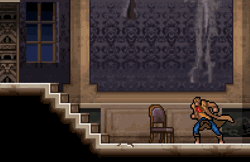 What’s the plot?
What’s the plot?
Soma is the reincarnation of Dracula, and, under normal circumstances, he stomps through a castle or two to squash whoever is pretending to the throne. However, there is a circumstance where he gets royally pissed off, and then Soma transforms into the Dark Lord himself. In this alternate timeline/bad ending, Julius Belmont takes whip in hand to vanquish the night.
How does it go?
Assuming you want to treat Soma like every other Dracula in Castlevania, it all goes pretty well. Julius recruits Yoko the Witch and Alucard the Handsome, beats every boss in this castle, and then banishes Soma to wherever Draculas go where they die (Pennsylvania?). Everyone feels a bit solemn out on that cliffside, and Mina has to hit Tinder, but the world is saved. Hooray.
What’s different?
Julius has the typical whip & sub weapons of his ancestors. Yoko has the ability to cast powerful spells and drain HP with a magic staff. Alucard has all the strength of a nighttime symphony. Together, they fight crime!
Does it work?
Does it ever! This was obviously an attempt to recapture the “character switching” action of Castlevania 3, and, give or take Hammer crawling around on the ceiling, it beautifully apes that beloved adventure. Julius has range, Alucard has speed and mobility, and Yoko has a risk/reward system for recapturing lost health. These seasoned heroes work so well together, it is a shame they never got their own game where they could quest without crying all the time.
Does it look good?
It’s all over the place. Alucard’s luxurious Playstation sprite returns, and it is a wonder to watch him slash opponents and sit in chairs (it’s the little things in life). There is even the cute addition of Julius and Yoko appearing in mirrors, but the dhampir Alucard not earning a reflection. On the other side of the coin, his compatriots’ double jump animations are behemoth poop, and Fake Succubus Yoko has more detailed animations than her real counterpart. Castlevania is a land of contrasts.
Is there progression?
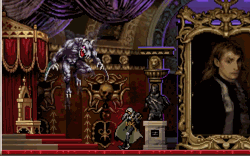 Like Ecclesia, you have to beat every boss across the castle to reach the final area. But more importantly, you start this one as a solo Julius, and Yoko and Alucard must be found elsewhere in the castle. This makes this the only alternative mode on this collection where you get more attack/movement options as you make progress. We got a true metroidvania up in here!
Like Ecclesia, you have to beat every boss across the castle to reach the final area. But more importantly, you start this one as a solo Julius, and Yoko and Alucard must be found elsewhere in the castle. This makes this the only alternative mode on this collection where you get more attack/movement options as you make progress. We got a true metroidvania up in here!
Is it any fun?
This feels like the alternate mode that got the most directorial vision. Castlevania: Dawn of Sorrow is a great game in its base mode, but it is very much more of the exact same gameplay as Castlevania: Aria of Sorrow. This alternative mode took something that had been kicking around for eight years (play as the “old” Castlevania protagonist in the “new” Castlevania environment), and made it new and fresh. And devoid of horrible gimmicks! It’s damn fun.
Anything else?
This alternate mode is the only one that gets its own unique boss in the form of Soma-Dracula. Considering there is just enough of a twist on the classic formula to make this battle unique (Soma utilizes some of the coolest soul-attacks in the game), it is a welcome addition to Dracula canon. Soma is his own man. He can forsake hellfire for a giant axe if he wants.
FGC #676 Castlevania Dominus Collection
- System: We’ve got this one on Switch, Steam, Playstation 5, and Xbox X|S. Not bad for a collection of games previously only seen on the friggen’ Nintendo DS.
- Number of players: It looks like those vestigial 2 player modes are technically still there, so we are going to count ‘em.
- Favorite Boss (Collection): Good ol’ Gergoth. Nothing beats Gergoth.
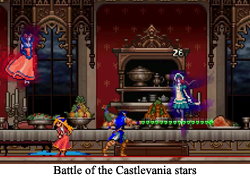 What about Richter Mode? In addition to Sisters Mode, Castlevania: Portrait of Ruin contains Richter Mode, where you can play as Richter and Maria Renard from their Rondo of Blood incarnations. This mode is amazing, as Richter is a speedy little monster, and Maria is a dove-flinging beast. Alas, I only have time to cover one alternative mode per game, and the dreadful Sisters Mode does at least have an associated plot.
What about Richter Mode? In addition to Sisters Mode, Castlevania: Portrait of Ruin contains Richter Mode, where you can play as Richter and Maria Renard from their Rondo of Blood incarnations. This mode is amazing, as Richter is a speedy little monster, and Maria is a dove-flinging beast. Alas, I only have time to cover one alternative mode per game, and the dreadful Sisters Mode does at least have an associated plot.- Let’s go to the arcade: Haunted Castle is also included on this collection. This is the weird, arcade-based Castlevania that nobody likes. Fun fact: I do not like it, either. It is old school Castlevania, but a little too sadistic for my tastes. Much like Battletoads Arcade, I have literally no doubt that someone involved was deliberately ramping up difficulty in favor of earning more children’s quarters. This should be considered a crime.
- Let’s go to the M2: And we’ve got Haunted Castle: Revisited, too! M2 took the time to make a version of Haunted Castle that isn’t completely horrible, and it is… fine. While I know there is disagreement on this fact, I see this as something similar to Castlevania: The Adventure Rebirth. It is just slightly less drastic, as the producers had more game to work with than the Gameboy conversion. Whatever the case, this is Haunted Castle as a more traditional Castlevania, with less horrible challenges, and nostalgic subweapons replacing bombs and power-clocks. Many Haunted Castle set pieces are retained, and there is one cool Frankenstein fight, but… Hate to say it, but Haunted Castle sanded down to be more traditional makes it a lesser Castlevania (1), and we already have plenty of ways to revisit Castlevania.
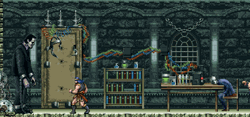 Let’s boo M2: Haunted Castle: Revisited is the only game within the collection that does not allow for distinct save states or rewinding. While I understand the impulse for a director to want to see their new game played “properly” without emulation-based tricks, it feels genuinely disingenuous next to every other game on the collection offering these benefits. You cannot tell me that Castlevania: Order of Ecclesia and its medals for beating bosses without ever taking a hit wanted to include a corollary of “you still get the trophy if you rewind infinitely”. You think you’re better than one of the best Castlevanias ever, Haunted Castle: Revisited? Huh?!
Let’s boo M2: Haunted Castle: Revisited is the only game within the collection that does not allow for distinct save states or rewinding. While I understand the impulse for a director to want to see their new game played “properly” without emulation-based tricks, it feels genuinely disingenuous next to every other game on the collection offering these benefits. You cannot tell me that Castlevania: Order of Ecclesia and its medals for beating bosses without ever taking a hit wanted to include a corollary of “you still get the trophy if you rewind infinitely”. You think you’re better than one of the best Castlevanias ever, Haunted Castle: Revisited? Huh?!- Watch it, buddy: Oh, we played this collection on Even Worse Streams, too. Here it is:
Along with some Jonathan/Charlotte times, I ran through the first three levels of Haunted Castle and Haunted Castle: Revisited. Please enjoy much complaining about The Gnome Dimension.
- Did you know? Castlevania: Aria of Sorrow takes place in the far-flung future of 2035 (with Dawn of Sorrow a mere year later). Only a decade or so until Drac is back!
- Would I play again: I am so likely to replay this collection again. Playing through these three games in rapid succession (and then conquering their alternate modes) kind of makes me want to replay all the Castlevanias. Maybe I’ll run that by the streaming crew…
What’s next? Random ROB is still in a Halloween mood and has chosen… Ghost Trick: Phantom Detective! And that’s no trick! Please look forward to it!
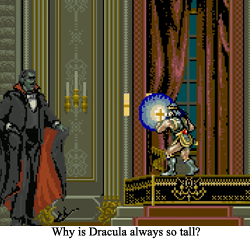

Okay, you mentioned Richter Mode in the footnotes, but Portrait of Ruin also has Old Axe Armor mode. It’s basically like “What if Alucard’s Axe Armor was actually viable for completing the game?” and you have stuff like better jumping and a high jump and special moves via button combos and that puppet throwing thing from Dawn. It can be quite fun to tear through foes.
That said, it does require killing a ludicrous number of Old Axe Armors (1K) to unlock.
[…] game! And it’s all good! And has got Galamoth! And the best finale for Vampire Survivors this old Castlevania-head could have ever hoped for! Maybe I should have just named Ode to Castlevania my game of the year, […]